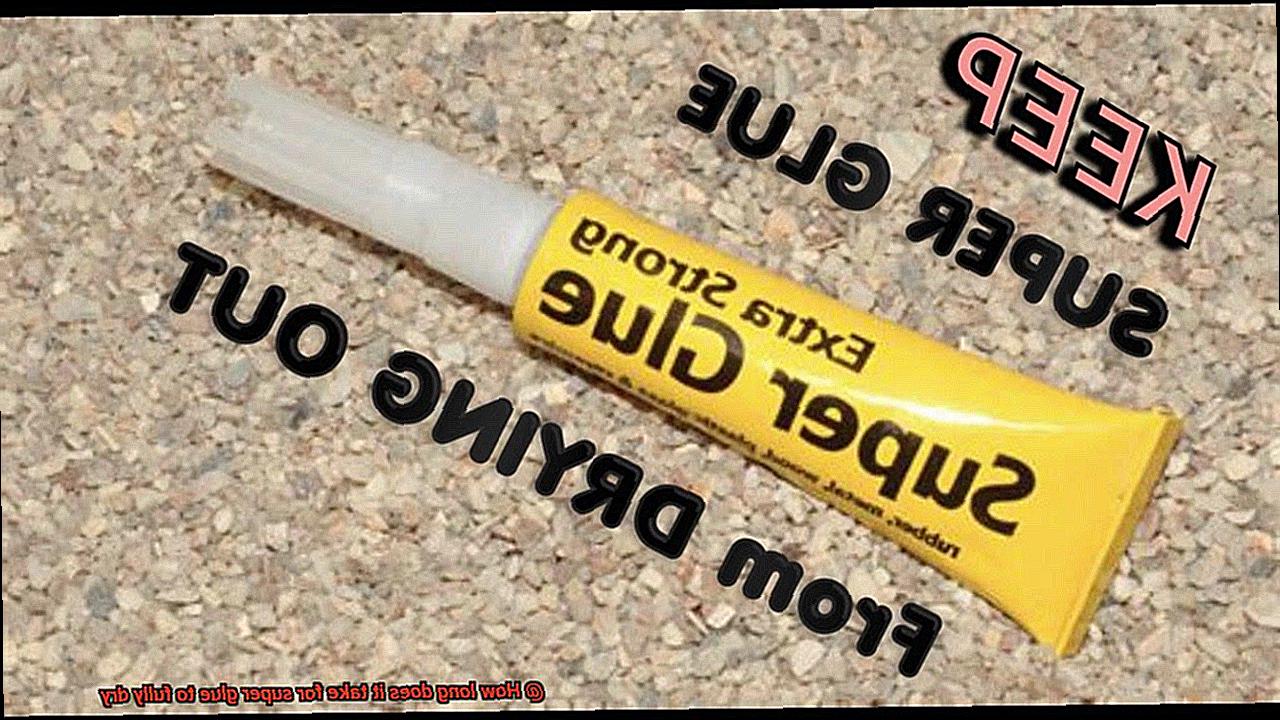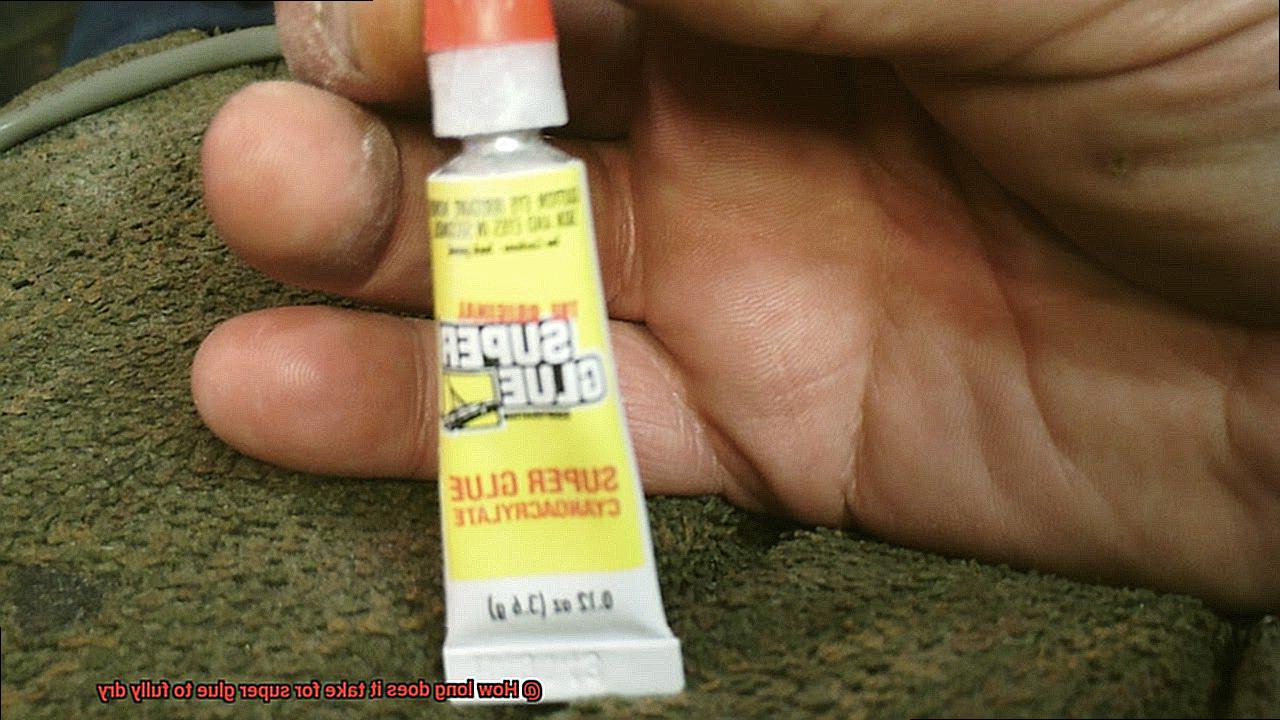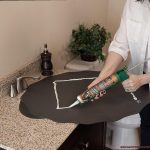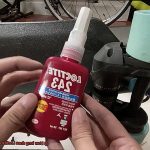We’ve all been there – that heart-stopping moment when our precious project or cherished heirloom takes a nosedive. But fear not, for super glue comes to the rescue, promising to save the day. Yet, as we anxiously watch it set, we can’t help but wonder: how long does this stuff actually take to dry? Well, today we’re peeling back the layers of mystery surrounding super glue’s drying time.
Patience is key when it comes to super glue. Though it seems simple enough, several factors can significantly impact its drying time. So let’s dive into the nitty-gritty details and discover just how long you’ll need to keep your patience intact.
Temperature plays a starring role in this sticky drama. Higher temperatures speed up the drying process, while colder conditions slow it down. Whether you’re battling a project in sweltering summer heat or braving winter’s icy grip will determine just how long you’ll have to wait.
But wait, there’s more. Humidity also holds sway over super glue’s drying time. High humidity drags out the process as excess moisture in the air hinders solid bond formation. On the flip side, dry environments expedite drying, allowing you to get back to business sooner.
The type of surface you’re gluing also has its say. Non-porous materials like glass and metal are super glue’s best friends and lead to faster drying times. However, porous substances such as wood or fabric may absorb the glue and extend drying time a touch longer. Keep these factors in mind when planning your timeline.
Intrigued? Stick around for future blog posts where we’ll plunge deeper into the world of super glue. We’ll explore projects that benefit most from its magical powers, share tips and tricks for achieving an unbreakable bond, and even reveal the best methods for speeding up drying time without sacrificing quality.
So, whether you’re a DIY enthusiast or just enjoy fixing things around the house, buckle up. Our super glue adventure is just beginning, and we’re thrilled to have you along for the ride.
Factors that Affect Drying Time
Contents
Super glue is a fascinating adhesive with its ability to bond materials quickly and securely. But have you ever wondered why it sometimes takes longer for super glue to dry? In this article, we will delve into the factors that influence the drying time of super glue, shedding light on the science behind this process and providing valuable insights to optimize your glueing experience.
Type of Super Glue:
The type or formulation of super glue you choose can have a significant impact on its drying time. Different types, such as cyanoacrylate, epoxy, and gel-based glues, possess unique compositions and chemical properties that influence their drying characteristics. Be sure to consult the product label or instructions to determine the specific drying time for the super glue you are using.
Temperature and Humidity:
The environment in which you apply super glue plays a crucial role in its drying time. Higher temperatures accelerate the chemical reaction that causes the glue to harden, resulting in faster drying. Conversely, colder temperatures can slow down the process. Similarly, high humidity can prolong the drying time as excess moisture interferes with the curing process.
Surface Type and Condition:
The material or surface on which you apply super glue also affects its drying time. Porous surfaces like wood or fabric tend to absorb some of the glue, extending the drying time. On the other hand, non-porous surfaces such as glass or metal allow for quicker drying as they do not absorb the adhesive. Additionally, clean and dry surfaces provide better adhesion and promote faster drying compared to dirty or moist surfaces.
Amount of Glue Applied:
The amount of super glue you apply can impact its drying time. Applying a thin layer allows for better exposure to air and promotes quicker evaporation of solvents present in the adhesive, resulting in faster drying. Conversely, using an excessive amount of glue can increase drying time as it takes longer for all layers to cure fully.
Pressure and Contact Time:
Applying pressure to the glued surfaces during the drying process can help accelerate bonding and drying time, particularly with cyanoacrylate glues. Additionally, holding the surfaces together for a longer period allows the adhesive to set and bond more effectively, reducing drying time.
Temperature and Humidity
The relationship between temperature and humidity is a crucial factor in understanding the drying time of super glue. These variables play a significant role in the curing process of adhesives, including super glue. By delving deeper into how temperature and humidity impact drying time, users can make informed decisions when working with this powerful adhesive.
Let’s start with temperature. Higher temperatures tend to accelerate the curing process, resulting in faster drying times for super glue. This is because heat increases the reactivity of the chemical components in the glue, promoting faster cross-linking and solidification. On the other hand, lower temperatures slow down the curing process, leading to longer drying times for the adhesive.
Humidity, or the moisture content in the air, also affects the drying time of super glue. In humid conditions, where there is high moisture content, super glue may take longer to dry. The excess moisture can interfere with the adhesive’s ability to cure properly and may result in a weaker bond. Conversely, dry environments with low humidity promote faster drying times for super glue as there is less moisture to hinder the curing process.
It is important to note that extreme temperatures and humidity levels can have adverse effects on super glue’s overall performance. Excessive heat can cause the adhesive to degrade or become brittle, compromising its bonding strength. Similarly, excessive humidity can lead to a weaker bond and potential failure of the adhesive.
To optimize drying time and ensure a strong bond, it is recommended to use super glue within its specified temperature range. Most super glues work best at room temperature, typically ranging between 20-25 degrees Celsius (68-77 degrees Fahrenheit). This temperature range provides an ideal balance between fast drying times and optimal bonding strength.
In situations where temperature and humidity conditions are not ideal, there are ways to mitigate their effects on super glue drying time. For instance, if the environment is too cold, using a heat source like a hairdryer set on low heat can help accelerate the curing process. However, caution should be exercised not to apply excessive heat, as it can damage certain materials or cause the glue to cure unevenly.
In humid conditions, using a dehumidifier or air conditioning can help reduce the moisture content in the air, promoting faster drying times for super glue. Additionally, ensuring that the surfaces being bonded are clean and dry before applying the adhesive can minimize the impact of humidity on the drying process.
Thickness of the Glue Layer Applied
Well, I have some exciting news for you. The thickness of the glue layer you apply actually has a significant impact on how quickly super glue dries. Let’s delve into the details and uncover the secrets of glue drying time.
Thin is in when it comes to super glue. Thin layers of glue dry much faster than thick ones. Why? It’s all about air exposure. A thin layer allows more air to reach the glue, promoting the curing process. Think of it like airing out a room – the more windows you open, the quicker fresh air can circulate, right?
On the flip side, slathering on a thick layer of glue creates a barrier that prevents air from easily reaching the inner layers. And no air means no drying. So, if you’re in a hurry, go easy on the glue and keep it thin.
But here’s a pro tip: if you need a really strong bond, applying multiple thin layers can be more effective than one thick layer. Each thin layer can dry individually before adding another, leading to a stronger and faster bond overall. It’s like building a sturdy brick wall – one brick at a time.
Now, let’s not forget about our environmental factors. Temperature and humidity also play a role in drying time. Higher temperatures speed up the drying process, while lower temperatures slow it down. So, if you’re working in a chilly garage, grab a heater or find a warmer spot to speed things up.
And beware of excessive humidity. Moisture in the air can interfere with the curing process and leave you waiting longer than expected. So, make sure to work in a well-ventilated area with moderate humidity levels for optimal drying results.
Accelerators and Activators

If you’ve ever wondered how to speed up drying time and strengthen your super glue projects, get ready for a deep dive into the world of accelerators and activators. In this blog post, we’ll uncover the hidden secrets behind these powerful tools and explore how they can revolutionize your bonding experience.
Accelerators: Need for Speed
- Cyanoacrylate Accelerator: This superstar substance, available in spray or brush-on form, works like magic. When applied to the glued area, it triggers a rapid reaction with cyanoacrylate molecules, causing them to solidify at lightning speed. Perfect for immediate bonding or challenging materials that are difficult to hold in place.
- Heat: Who knew heat could be a glue’s best friend? By applying heat to the glued area, you can increase the temperature of the surroundings, accelerating the chemical reaction between super glue and the surface. But beware of excessive heat—it can weaken bonds or damage certain materials.
Activators: Initiating Instant Bonds
Important Considerations:
- Follow Instructions: Just like any superhero needs instructions, it’s crucial to follow the guidelines provided by the super glue manufacturer when using accelerators and activators. Each brand may have specific recommendations for their use.
- Material Compatibility: Not all materials react the same way to accelerators or activators. It’s important to consider compatibility with the materials being bonded. Some materials may experience discoloration or a weakened bond due to incompatible reactions.
The Art of Balancing Speed and Strength:
While accelerators and activators speed up drying time, it’s essential to strike a balance between quick drying and bond strength. Rapid drying may not allow sufficient time for the glue to penetrate and bond effectively. Evaluate the trade-off between speed and strength before using accelerators or activators.
Allowing Sufficient Curing Time
Today, we delve into the captivating world of super glue and why it is imperative to exercise patience and allow for sufficient curing time. Super glue, also known as cyanoacrylate adhesive, is a powerful bonding agent that can join different materials with ease. However, rushing the drying process can compromise the strength and longevity of your bond. So, let’s explore the reasons why giving super glue the time it needs to cure is vital for successful bonding.
Factors Affecting Curing Time:
- Thickness Matters: Thicker layers of super glue take longer to cure as they trap more moisture inside. Thin layers dry quicker due to better exposure to air.
- Material Influence: Porous materials like wood or fabric absorb moisture from the glue, extending drying time. Non-porous materials such as metal or glass don’t absorb moisture and thus dry faster.
- Environmental Conditions: Temperature and humidity play significant roles in the curing process. Higher temperatures accelerate drying, while lower temperatures slow it down. Low humidity levels prolong drying times, whereas high humidity can expedite the process.
Importance of Sufficient Curing Time:
- Strength Development: While super glue may appear dry within seconds or minutes, it requires hours, if not days, to reach its maximum strength. Rushing the process can result in weaker bonds that may fail under stress.
- Longevity of Bond: Allowing super glue to fully cure ensures a durable and reliable bond. By granting ample curing time, you enhance the bond’s ability to withstand various stresses and strains over time.
- Avoiding Bond Failure: Disturbing or applying pressure to bonded objects before they have fully cured can weaken the bond and lead to failure. Patience is key to achieving optimal results.

Accelerating the Process:
- Accelerator Products: If time is of the essence, you can use accelerator products specifically designed for super glue. These products speed up the curing process and reduce drying time. However, it is crucial to ensure compatibility with your chosen materials.
- Manufacturer’s Instructions: Different brands and formulations of super glue may have varying drying and curing times. Always consult the manufacturer’s instructions for specific guidance on curing times for the product you are using.
Removing or Repositioning Bonded Items
Accidentally bonding items together or needing to reposition them can be frustrating, but fear not. In this comprehensive DIY guide, we’ll explore simple yet effective methods for removing or repositioning bonded items using common household items like acetone, heat, dental floss, and thin flat objects. Get ready to roll up your sleeves and dive into the secrets of un-bonding.
The Magic of Acetone:
- Soak a cotton ball or swab in acetone (found in nail polish remover).
- Apply the acetone-soaked cotton ball or swab to the bonded area.
- Allow a few minutes for the acetone to dissolve the super glue.
- Gently separate the bonded items.
- Repeat if necessary until the bond loosens enough for easy removal.
Unleash the Power of Heat:
- Use a hairdryer on a low heat setting or warm water to apply heat to the bonded area.
- The heat weakens the super glue bond.
- Gently separate the items while applying heat.
- Avoid excessive force to prevent damage.
Dental Floss/Fishing Line Technique:
- Slide dental floss or fishing line back and forth between the bonded items.
- Gradually saw through the bond.
- Loosen the bond and reposition the item as desired.
Thin Flat Object Method:
- Use a credit card or spatula as a thin, flat object.
- Carefully insert it between the bonded items.
- Apply gentle pressure to pry them apart.
- Exercise caution to avoid excessive force and damage.
Important Reminders:
- Test removal or repositioning methods on a small, inconspicuous area first, especially for delicate or porous materials.
- Seek professional assistance for valuable or sentimental items to ensure their safe removal or repositioning.
Tips for Quicker Drying Times
We’ve got you covered. Super glue, also known as cyanoacrylate adhesive, is a powerful bonding agent that can hold materials together in a snap. But what if you’re in a hurry and need it to dry quickly? We’ve gathered some handy tips and techniques to help you speed up the drying time of super glue. Let’s dive in.
Clean and Dry Surfaces:
Before applying super glue, make sure the surfaces you want to bond are clean and dry. Dirt, dust, and moisture can slow down the drying process. Imagine trying to stick two pieces of metal together with a layer of dirt between them—it’s like trying to bond with a slippery obstacle. Use a mild detergent or rubbing alcohol to clean the surfaces thoroughly. Remember, a clean surface means a faster bond.
Thin Layers:
Instead of slathering on thick layers of super glue, try applying thin layers. This allows the solvents in the adhesive to evaporate faster, speeding up the drying time. Think of it as spreading butter on toast—you want a thin, even layer that melts quickly. Use small amounts of glue and spread them evenly over the surfaces you want to bond. Less is more.
Temperature Matters:
Higher temperatures can accelerate the drying process, while colder temperatures can slow it down. If you want your super glue to dry faster, try warming up the glued surfaces with a hairdryer set on low heat. Just be careful not to scorch your project or set off any smoke alarms—it’s all about finding that sweet spot. By raising the temperature, you’re giving the glue an extra boost of energy to form those strong bonds.
Accelerators or Activators:
Accelerators or activators are specially designed products that can significantly reduce super glue’s drying time. These magical potions promote a chemical reaction that speeds up curing. It’s like adding fuel to a fire—the glue ignites and dries in a flash. Spray or brush on the accelerator before or immediately after applying the super glue for lightning-fast results. Just watch out for any sparks.
Apply Pressure:
Applying pressure to the bonded surfaces helps create a stronger bond and expels excess moisture from the adhesive, leading to quicker drying times. It’s like giving a firm handshake—it shows that you mean business. You can use clamps, rubber bands, or even your hands to hold the materials together firmly while the glue dries. Squeeze that bond tight. The pressure pushes out any lingering moisture and encourages the glue to set more rapidly.
SG4gOpHZTBM” >
Also Read: How Long Does Super Glue Take to Dry?
Conclusion
Super glue, a powerful adhesive that can bond almost anything together, is known for its quick-drying properties. But just how long does it take for this mighty glue to fully dry? Well, the answer depends on various factors such as the type of super glue used, the materials being bonded, and the environmental conditions.
In general, most super glues are designed to dry within minutes. Yes, you read that right – minutes. This rapid drying time is one of the reasons why super glue is so popular for quick fixes and repairs. However, it’s important to note that while the glue may appear dry on the surface after a few minutes, it may still need some additional time to reach its full strength.
To be on the safe side, it’s recommended to allow at least 24 hours for super glue to fully cure. During this time, the adhesive undergoes a chemical reaction called polymerization, which strengthens and solidifies the bond. So even if your project seems secure after just a few minutes, exercising patience and giving it ample time to dry completely will ensure a stronger and more durable result.
Of course, certain factors can affect drying time. For instance, humidity levels play a role in how quickly super glue dries. Higher humidity can slow down the drying process, while lower humidity speeds it up. Additionally, thicker applications of glue or bonding porous materials may also require more time to dry thoroughly.
In conclusion, while super glue may seem like an instant fix-it solution with its rapid initial drying time, allowing 24 hours for full curing is advisable for optimal results.






